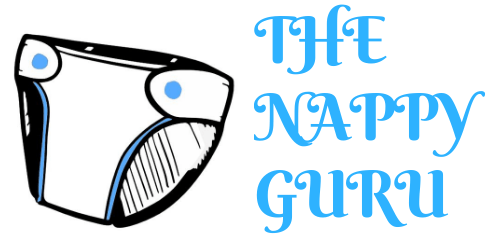Cloth Nappies 101 - For New Cloth Nappy Users
Using a nappy library service is the smartest way to get into cloth nappies – especially if you’re brand new to the process.
It allows you to try out different brands and work out which ones will best suit your lifestyle, your baby and your budget before you invest in purchasing some of your own.
Rebates and subsidies are now available for residents of the City of Armadale, City of Cockburn, City of Vincent, City of Melville, City of Fremantle and Town of East Fremantle, City of Bayswater and Town of Bassendean right here in WA!
Below is a great comparison chart from Clean Cloth Nappy Hire that outlines the benefits of hiring cloth nappies compared to buying disposables and buying new cloth nappies.
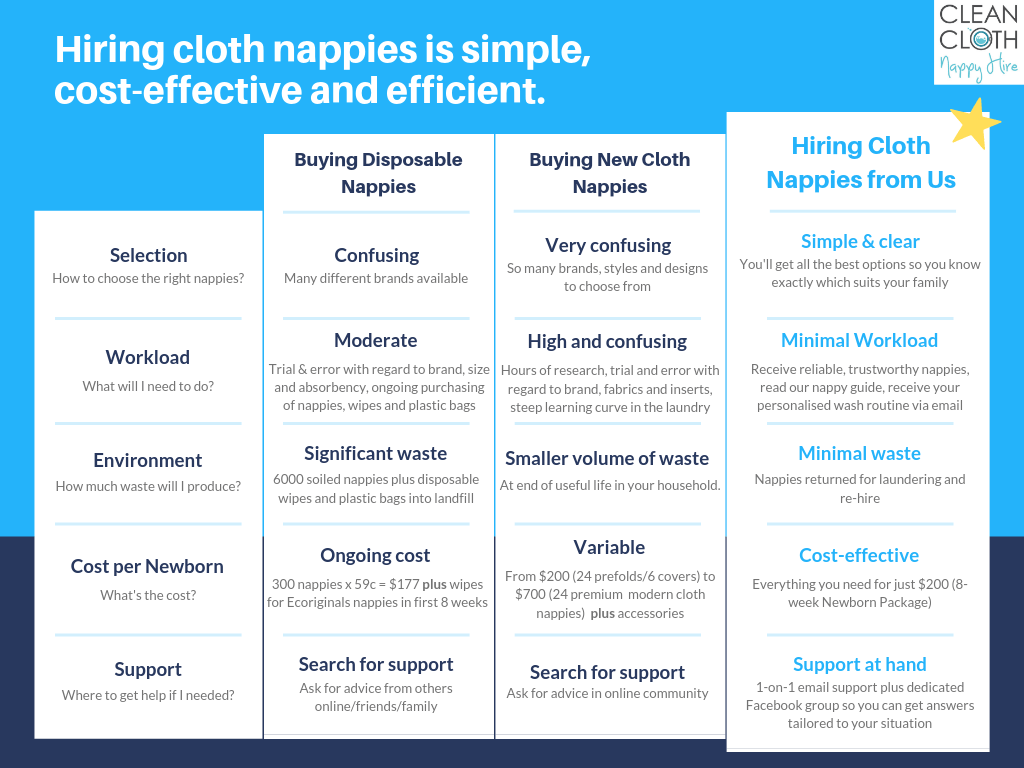
It’s risky to buy bulk packs of more than 6 nappies of the same brand if you haven’t tried them before.
If you want to buy brand new cloth nappies, we recommend buying trial packs of different brands first. Your local council may be offering rebates for purchases too – so grab a copy of the available discount codes to purchase nappies by attending a Nappy Guru workshop. They are happening all over the Perth Metro area and online.
Start with 1 or 2 reusable nappies per day and treat those nappies like any other piece of clothing that got wee or poo on it.
Give the poo a flick and the cloth a good hand rinse, squeeze out the excess water and add it to your wash pile.
If you think washing nappies is going to take over your life – don’t worry – it won’t… If you can spare an extra 10 minutes each day and an extra two loads of washing per week, you can definitely do cloth nappies!
Don’t be too hard on yourself! As with starting anything new, there is a learning curve. Leaks and nappy rashes occur in both reusables and disposable nappies. If it gets overwhelming – take a break and ask for help! See the chat box down there in the right? Feel free to use it 🙂
Did you know: Doing cloth nappies part time or even occassionally is better than doing none at all and most cloth nappy parents are part timers!
Newborns go through about 10-12 nappy changes per day. So if you wish to do full time cloth nappies and wash only every second day, then 30-36 nappies are needed. Newborn sized cloth nappies can usually fit babies from 2kgs – 8kgs, so from birth to approximately 4-12 weeks – depending on the baby’s size and how fast they are growing.
Infants, toddlers and older children will need 6-10 OSFM nappies per day if they are changed every 2-3 hours. For full time use and washing every second day, a stash of 20-30 cloth nappies will be ideal. Most OSFM nappies will best start fitting from 5kgs onwards.
Wash brand new nappies/inserts at least once before popping them on your baby to remove manufacturing residues.
It can take up to 6 or 8 washes before new nappy inserts reach their full capacity, so we recommend washing new nappies more frequently.
Your hire kits may contain some brand new nappies and you will need to wash these before use.
Yes indeed. It is also the perfect time to get everyone on board with your partner, friends and family who are willing to help and find out together how it all works 🙂
Our Newborn nappy hire kits contain everything you need to get started. All you need to provide is the baby, a washing machine and a clothes line!
Another option is to purchase 30-35 terry flats, flannelette flats or pre-folds with 6-10 newborn sized covers. The simplest fold is a pad fold , but you can check out our Youtube channel for the fast origami fold for flat nappies which is perfect for newborns. Or why not try some pre-flats – you can even make them yourself!
Other great things about the newborn stage is that:
– Exclusively Breast Fed (EBF) baby poo rinses out very easily – so you can put them straight in the washing machine.
– Newborn poo is NOT stinky or horrible, in fact newborn poo has a sweet smell. Cloth nappies don’t stink out your room or your bin like disposable nappies would either.
– Newborns don’t do the crocodile roll- so getting the nappy on is super easy.
If you have OSFM nappies, why not try them on your newborn? Check out the OSFM nappy Newborn Hack on Youtube.
Budget inserts made of microfibre or Bamboo Charcoal have the lowest capacity, but they are fast drying and fast absorbing. If they are at full capacity they are prone to compression leaks.
Cotton is a better alternative, with fast absorption and a higher capacity. It also has the added bonus of being fast drying.
Hemp and Bamboo have the highest capacity, however they can be slow to absorb and they take the longest to dry.
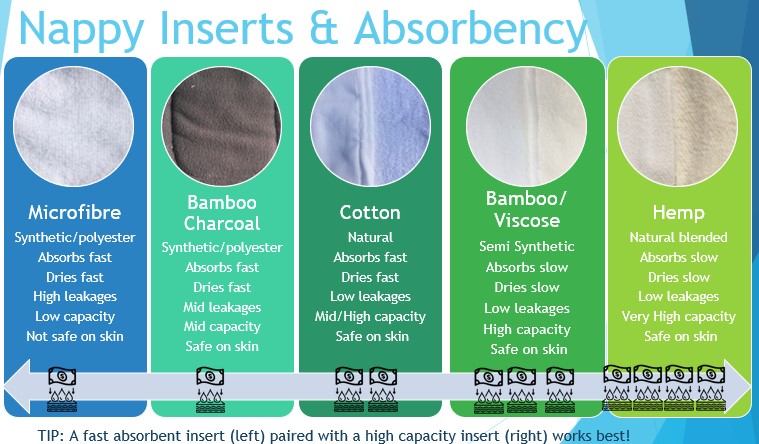
Two inserts are better than one! Pair a microfibre insert with cotton, hemp or bamboo insert for fast absorption and high capacity!
Don’t be afraid to create your own “franken-nappy” by mixing different inserts with different covers to suit your baby’s output.
Cloth wipes can save you over $500 just for one child. Choose cotton flannelette, cotton velour or bamboo velour for the best wipes. You can even make wipes with old sheets, PJs or towels if you are handy with a sewing machine or overlocker. Or you can just purchase some face washers – it can be as easy as that 🙂
Use just plain water with cloth wipes. Wet as you go, or have the wipes pre-wet ready to use for the day. Try keeping a pop top bottle or squeeze sauce bottle near your change table. Dry your baby’s skin completely to reduce the chances of nappy rashes. Some people use a bottle warmer, a flask with warm water or small hot water bottle to get those wipes warmed before use!
We do not recommend the use of essential oils with cloth wipes. If you need a bit of fragrance, use a little baby wash. Aloe vera gel, witch hazel extract or oils such as olive, coconut or sweet almond, vitamin E or herbal tea such as chamomile would be okay – just be conscious of the amount you are using and that food allergies could be an issue.
If you’re heading out of the house, you can pop some of these wipes in a smaller plastic container or wet bag.
TIP: To ensure mould doesn’t grow on your wipes, change them out every day if keeping wet in a container.
Rinse out used wipes and wash with your nappies.
Cloth nappies do not give off offensive smells like disposables when soiled, so keep an ear as well as your eyes out or peek inside every few hours for those steal poos. .
Once detected, poo nappies need to be changed straight away – this will reduce the chance of nappy rashes.
Did you know you can leave the soiled nappies to be dealt with at the end of the day? Just fold the nappy in half and put it somewhere where no cats, dogs or kids can reach it.
When you are ready, plop the poo in the toilet and flush. Some toilet paper, a silicone brush or a nappy sprayer will be handy for sticky messes.
A quick rinse under the laundry tap, squeeze out excess water to stop drips and place the nappy in a “dry pail”.
A “Dry Pail” is an airy basket/laundry hamper that allows for air flow around your nappies to stop/reduce smells.
You can store used nappies and/or pre washed nappies in separately labelled dry pails.
Wet Pails – aka soaking buckets – are NOT recommended for MCNs as many nappy fabrics, elastics, water proofing layers start breaking down with prolonged soaking.
Try a Strucket for short soaks for just inserts, or when doing a Strip and Sanitise (less than 2 hours) and as a dry pail option.
Using metal baskets is a little risky as they may rust over time and leave rust marks on fabrics.
Rinse out all used nappies each morning or each night and store in a dry pail.
Every day or every 2nd day, do a short wash cycle (eg. Daily Wash or Quick Wash setting on your washing machine) with just the used nappies.
Add half the dosage of detergent recommended for “heavily soiled” loads to remove the majority of the wee and poo off your nappies. Choose 40-60 deg C temperature and the highest spin setting on your machine. Remove from machine and store in a separate dry pail – no need to dry and they won’t drip.
On the 2nd or 3rd day when you have enough for a “full load,” do a long wash cycle (eg. Cottons or Heavy Duty) that runs for 2-3 hours. Add the recommended dose of detergent for “heavily soiled” laundry. Choose 40-60 deg C for temperature and choose the highest spin speed on your machine.
We can help you with your own Personalised wash routine to CleanClothNappies.com standards to get you started.
You maybe wondering why two washes? Well… two washes in clean water each time will ensure you have nappies that are in pristine condition (think re-sale value!!!) and will prevent nappy rashes, smells and stains in the long run. Think of the short wash cycle like a “flush” before cleaning the toilet and long wash as your “thorough clean”.
Don’t worry, in no time at all, washing nappies will just become a small part of your daily routine.
If you are worried about costs of water, electricity and detergents that may be involved in washing nappies it adds to be around $1.50 to run both cycles.
Drying nappies in winter? Use a cloth airer or a peg hanger in a well ventilated room with a heater or fan already on this way no extra electricity usage will required!
In the heat of summer, do not leave nappies out in direct sunlight as high heat and UV can cause damage to nappy covers and elastics.
If using a dryer, stick to low setting for covers or medium setting for inserts. Do not stretch any elastics straight out of the dryer as they will get damaged.
Use a commercial detergent. Biozet Powder and Omo are popular detergents amongst cloth nappy users.
Eco/sensitive detergents like Omo Sensitive or Eco Store powder works well if washed in a hot cycle (60 deg C) but may need a stain removing booster like Sard or Vanish.
We’re sorry to say, but soap nuts will not work – they have been proven to work worse than water alone! There are some other detergents that also won’t work well for cloth nappies.
Check out cleanclothnappies.com to see if the detergent you want to use has been tested by cloth nappy users and what dosage and temperature they recommend. You may have to pay a monthly fee for this service.
If you prefer a liquid detergent and want to reduce the plastic waste, try ZERO CO detergent. A discount of $25 will be given to anyone who signs up through the link at: https://tinyurl.com/zeroco.
Do not add fabric softeners to your wash – long term use can make nappies repel liquids. If inserts seem stiff, just pop them in the dryer on warm for a few minutes. Using laundry detergents with fabric softeners “built in” like Biozet with Softner powder, is okay.
We recommend using reusable microfleece liners. These will catch poos and will stop stains setting on the nappy itself, it will also keep baby’s skin dry.
You can buy microfleece fabric from Spotlight and cut to approx. 30 cm x 13 cm. They won’t fray. Wash liners and wipes in a mesh bag.
Another option is to use fabrics like athletic wicking jersey, silk and suede cloth for liners. You can either purchase fabric yourself and cut to size approx 30cm x 13cm or find makers on etsy or online.
Note about disposable bamboo liners – never flush these down the loo. You must dispose of solids in the toilet and place the liner in a landfill bin. These liners can cause redness due to moisture being retained on the skin. They are however handy for day cares where nappies gets changed every 2 hours like clock work and makes the educators job that much easier when it comes to dealing with a poo nappy.
High heat from sun exposure or extensive use of dryers, concentrated bleach and soaking for long periods will all cause delamination or cracks in the water proof layers of nappies.
Delamination is where the water proofing layers separate from the fabric. Unfortunately, delaminated or cracked PUL nappies cannot be repaired.
The good news is that we can repair elastics, snaps or velcro on most nappy brands – just ask!
Sorry but we are currently NOT taking any donations of nappies that require repairs.
 Yes, but only if you are disciplined! Unfortunately many of us – including myself- are tragic nappy addicts 🙂
Yes, but only if you are disciplined! Unfortunately many of us – including myself- are tragic nappy addicts 🙂
If you have the Pokemon’s “have to collect ’em all” attitude, you will lose money. Try to have a rule of “one in – one out” or find second hand whenever you can. Sell unwanted nappies to avoid becoming a hoarder. It’s harder to sell large bundles than small bundles. The value of second hand nappies have dropped significantly over the years.
Front loading washing machines are more economical than top loaders, saving money on water and electricity. Wash when you have a full load. A full load for a front loader is when it’s loosely packed to 2/3 and for top loaders, when they are 2/3 full.
Do not overdose or under dose on detergents.
If you have solar panels, wash your nappies mid day when sun is at it’s highest and your panels are producing maximum electricity.
Air dry nappies as much as possible or use a heat pump dryer as they are more energy efficient.
Get nappies repaired instead of just buying new. Stains can be removed doing a Strip and Sanitise wash.
Use reusable liners and reusable wipes instead of disposable liners and disposable wipes.
Try elimination communication to reduce the need for nappies, washing and other accessories.

The different types of Cloth Nappies are shown in the chart below:
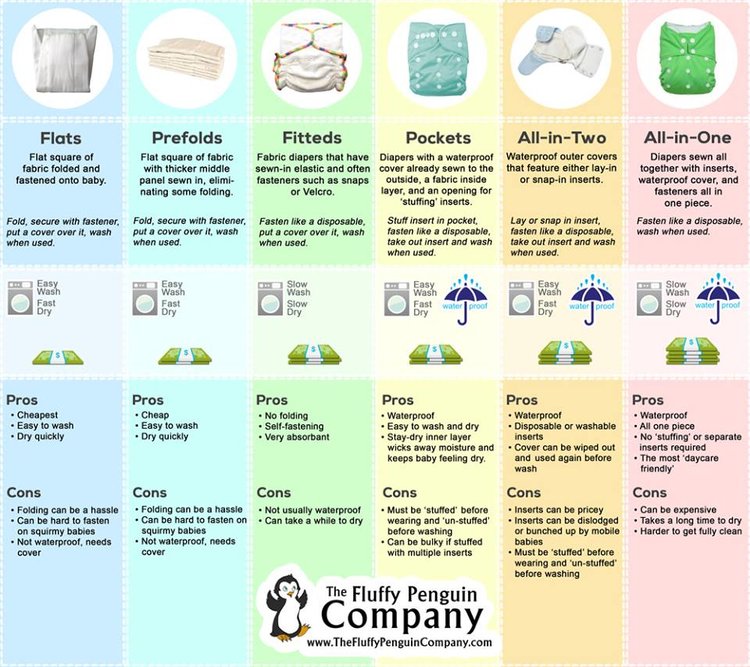
Here’s a flow chart that may help you choose the type that suits you & baby the best:

However if you are still stuck – try buying a few second hand, hiring cloth nappies or visiting a multi brand retailer to figure out what will suit you best.
DON’T BUY 24 Nappies of the same brand/model without trying them out first. Trial packs are available from most brands for discounted prices.
Simply fold prefolds in to pad shape and pop inside a nappy cover or pocket nappy.
Some more folding options below thanks to RAWr Nappies: 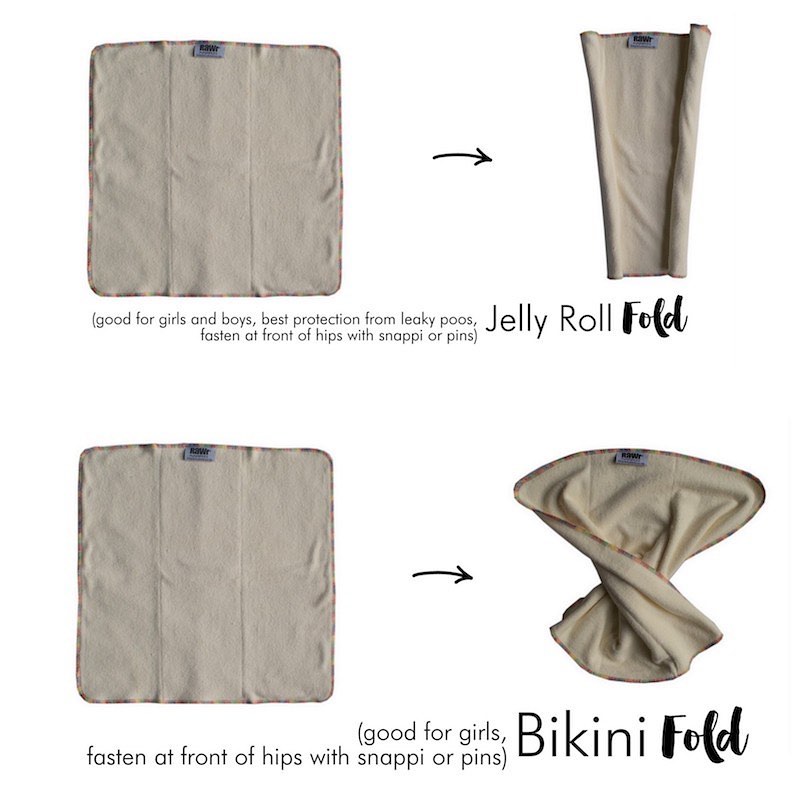
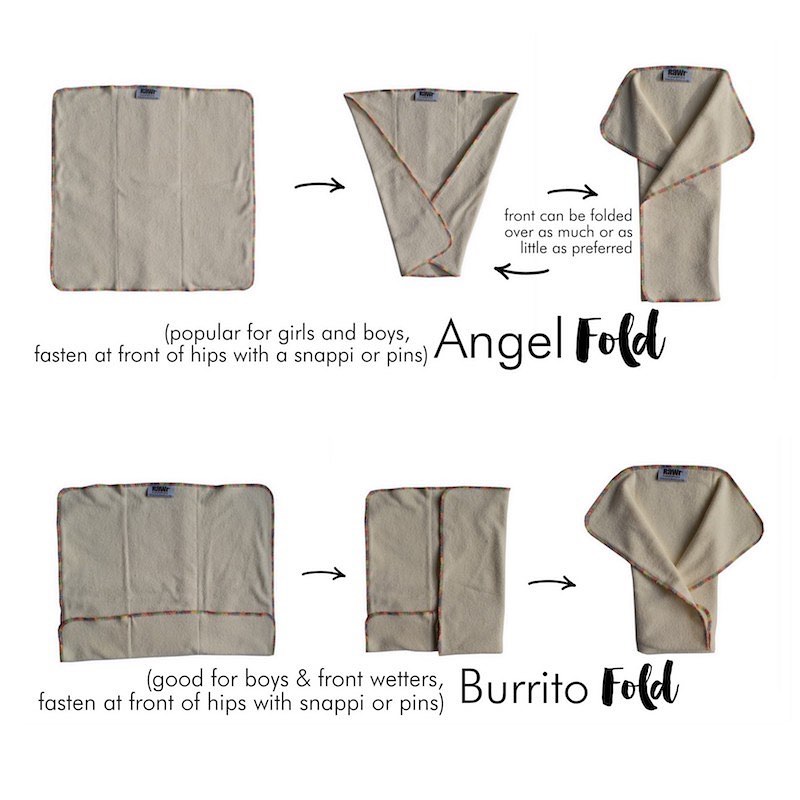
You will need a Snappi, Boingo or some safety pins to secure. A cover will be needed to make the nappy water proof. You can add other fabrics to increase absorpotion capacity, eg hemp, bamboo or cotton flannelette flats or even another prefold. Prefolds with their simplicity, will dry fast and will work well in humid climates and while travelling or camping.
SELL
- In small batches. Eg 3-6 nappies, separated by brand/type. Usually buyers are attracted to prices 50% or less than RRP
- Advertise on Facebook Marketplace, MCN buy/sell groups or Gumtree
- Be honest about the condition of your nappies, try including age and why you are selling
- Smells, stains and discolouration – try a strip and sanitise to remove these before selling
- Worn out Velcro, damaged snaps and slack elastics can be repaired – check how to videos online or get it done by us
- Delaminated or cracked PUL cannot be repaired – give them away for free, upcycle them or recycle them at H&M stores
DONATE
- Post as a Random Acts of Kindness (RAOK) or in Pay it forward groups or MCN groups on Facebook – spread the love and let many people get a chance to win by creating small batches of 3-10 and be prepared to send via post!
- Advertise on your local Buy Nothing Group on Facebook if you don’t want to send via post
- Ask your friends/family members if they want them for their children
- Cloth Nappies for Charity or Cloth Community Fund Australia or The Nappy Guru may take donations of nappies that don’t require repairs and in excellent to great quality – just ask!
- As above – let the receiver know about the true condition of the nappies
UPCYCLE
- Terry Towels/Prefolds can be used as cleaning cloths or absorbent pads to clean up spills around the home
- Natural fibre inserts will decompose – use them to line hanging baskets or flower pots to help retain moisture or add to your home compost/worm farm.
- Delaminated nappy covers can be used as swim nappies if elastics are still stretchy
- Get crafty – breast pads, make-up remover pads, menstrual pads, sand/rice filled sacks/balls, doll nappies or bunting can all be made using nappy fabrics.
- H&M stores take fabrics for recycling – we’re not sure where they end up though, so use this service as a last resort!
Yes of course they are.
First thing to do when you get your pre-loved nappies is to give them a long hot wash. We recommend a hot (60 deg C) on a Cottons cycle with a powerful commercial detergent like OMO or Biozet Powder. Add the detergent dosage recommended for “heavily soiled”.
Follow through with a santise wash. Instructions for the santise can be found here: https://tinyurl.com/NappySanitise
A sanitise wash will remove microbes like fungal spores (thrush) and will reduces stains and smells. You may need to do sanitise again if stains and smells persist.
A cloth nappy “re-set” also previously known as a Strip & Sanitise (S&S) can be performed to fix issues such as stains, smells, frequent nappy rashes and fungal infections.
A nappy sanitise is also highly recommended for all pre-loved or second hand nappies before they are first used on your baby.
Instructions are available from Cleanclothnappies.com (a monthly membership fee applies) and clothnappyhelp.com.au (free resource) and sacnu.com (South African based) websites and they all offer scientific reasons behind this process. Feel free to visit these sites to gain more of an in depth knowledge of this process.
For our nappy library hire service, a sanitise wash is completed after each nappy kit is returned to us before they go to the next family.
The instructions we follow for this sanitise wash is shown as an infographic below. Feel free to download it and use it next time you want to “Re-Set” your nappies. PDF is available here https://tinyurl.com/NappySanitise
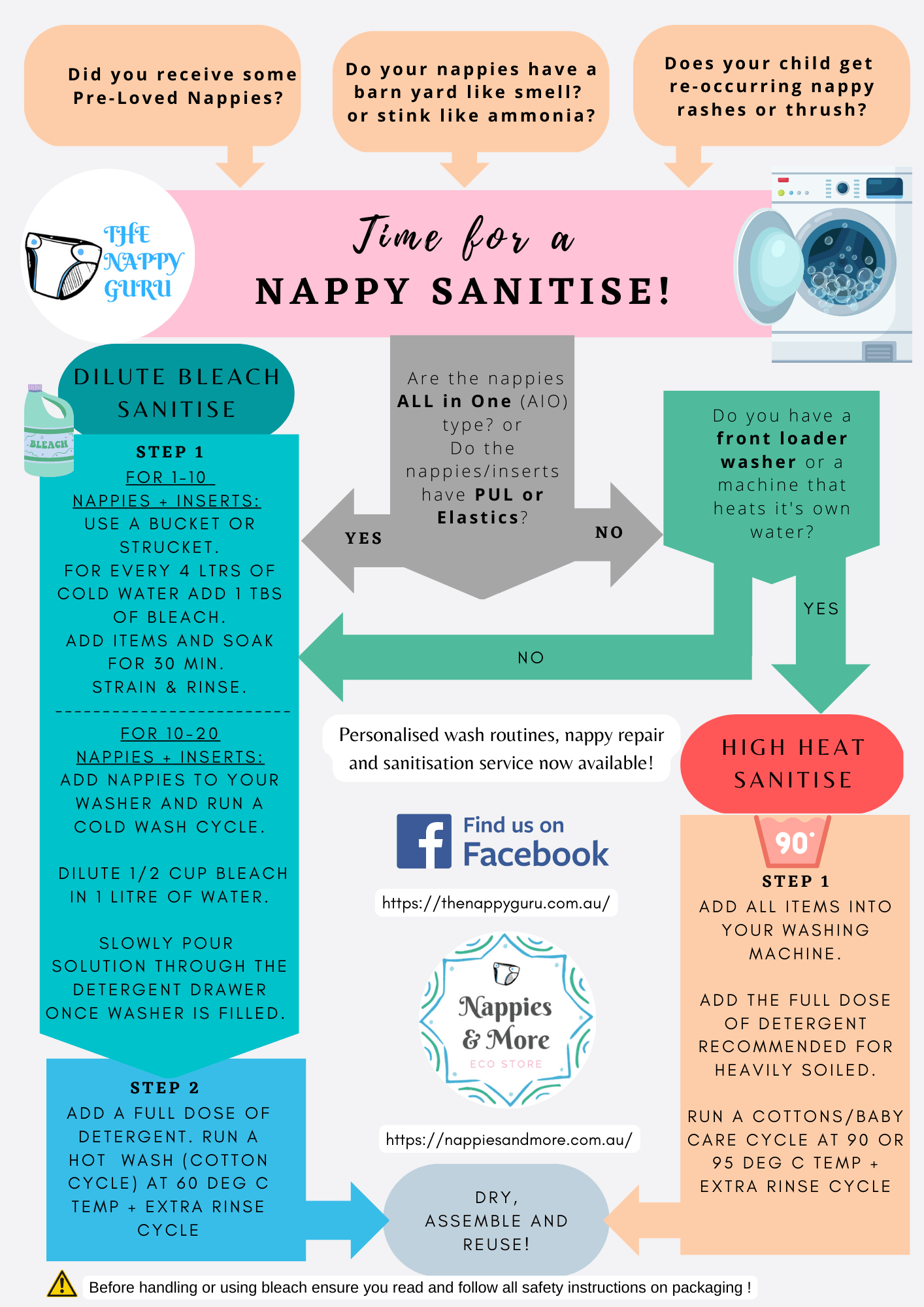
Feel free to contact us to help with trouble shooting re-occuring issues such as stains, smells, nappy rashes or thrush.
Be aware that frequent sanitising of nappies and inserts can lead to higher wear and tear and may effect your warranty due to use of high heat and/or bleach.
Unfortunately Soap Berries/Soap nuts are not powerful enough to wash soiled nappies.
Read about the tests performed by Choice regarding laundry cleaning, detergents and soap nuts here.
For a day out
- 1 x nappy (with inserts) for every 2 hours you will be out with liners already set up into the nappy.
- 2 x cloth wipes/nappy in a small wet bag or zip lock bag – keep them dry to eliminate mould issues
- 1 x nappy rash balm
- 1 x small bottle of water (Pop-Top style) to wet the wipes as you need. Baby change rooms have access to water close by.
- 2 x small wetbags to bring home poo nappies.
- 1 x Large wetbag for clothing and other items that may get wet
- 1 x hand sanitiser gel incase there’s no access to running water and soap for washing hands.
- 1 x Nappy Change pad with terry towel or other large muslin flat to cover the change pad or for emergency nappy!
If travelling overseas or interstate
Check you have access to a washing machine and your luggage restrictions if you are travelling by air. Don’t feel guilty if you choose not to use cloth nappies on your vacation. Be aware some countries like Vanuatu have banned disposable nappies so cloth nappies maybe required.
Traditional nappies like flat nappies or pre-folds or preflats will be better for ease of washing, drying as well as packing. Take as many as you can – I would suggest 20 rolled up to take up less room. Take some covers/pocket nappies (5-10) – these can be worn over disposables as a extra layer of defense against leaks.
Take a rolls of disposable liners or 10-20 microfleece liners to help with poo removal.
Washing powder (clearly labelled) or laundry sheets (eg Spacewhite or similar).
A Stain removal soap like sard soap will be a great addition.
Of course take your normal day trip nappy bag with items like your change mat. Be aware that small items like hand sanitiser, nappy rash balms may need to be in separate clear zip lock bags for security clearance.
Mini Breaks/ Road trips/Camping/Caravanning
You can access washing facilities at laundromats at Caravan Parks and check for public laundromats near you.
If you are staying at Air BnB or other short stay accommodation, check what laundry facilities are available before booking.
If you are staying in Hotel/Motels check what you have access to in your room or if they offer a laundry service and how much it costs. I’ve washed plenty of small items in bath tubs and sinks however space for drying was the major issue and so I had opted for disposable nappies.
Once you get back from your trip, wash nappies on a long hot washes or you can re-set your nappies by following the instructions for a nappy sanitse here: https://tinyurl.com/NappySanitise
Many cloth nappy families choose to use disposable nappies for night time and cloth nappy during the day.
Handy Tip: Use a nappy cover over a disposable nappy if you wish to contain leaks from disposables over night.
If you are ready to step into the final frontier of night nappies, You may like to figure out what your child’s output is like over night over a week or so or you can experiment with different combination of nappies.
Output for light wetters range between 0-200mL over night. You maybe able to get away with a day nappy.
For medium wetters ( output betwen 200-400mL) may require extra inserts or extra layers that are moslty made of natural fibres (ie cotton/bamboo hemp).
For heavy wetters – (400-600mL output) use a fitted nappy and a nappy cover. You can also boost with extra inserts between the nappy and the cover too.
For Extra Heavy Wetters – (over 600mL output) – a fitted nappy or a preflat nappy with extra layers between the nappy cover and the nappy near the child’s wetzone will be required to last 12 hours.
Wool covers and fleece covers are great options for over fitted nappies for nights.
Wool covers require special care as they can shrink in hot washes and detergent specifically for wool. You will also need to lanolise wool covers before use. Once lanolised you will only need to wash wool covers when they start to smell.
Fleece covers made of polyester is a more user friendly option as they do not require lanolising or special washing techniques. Just wash with nappies.
A big cloth bum is perfectly normal and baby’s sleep will not be affected if the nappy doesn’t feel wet or leaks out. Using microfleece liners near the skin will help keep child feeling dry.
For older children try bedwetter pants or pull up cloth nappies – they look like undies and have higher capacity.
Ensure you wash night nappies with hot water and detergent straight off the bum. This is to reduce the ammonia load that can build up and cause smell and nappy rash issues down the track.
If you wish to trial night nappies before purchase our night nappy hire kit can be booked here.
Unfortunately most synthetic fibres used in cloth nappies like microfibre, polyester, fleece and recycled PET do release microfibres when washed.
Remember though because of the use of cloth nappies you are reducing the amount of plastic going into landfill that also produce green house gas methane which is around 25 times worse than carbon dioxide!
There are special products out there like cora balls, Guppy Friend wash bags and special filters that can be used to reduce microplastics being released through washing.
By consciously choosing to use cloth nappies, we are reducing our use of raw materials that goes into making disposables and therefore reducing our impact on this planet overall.
Reusable products that go hand in hand with cloth nappies include Cloth Wipes, Reusable Liners, Breast pads and eliminating one time use products like disposable nappy bags and disposable change pads etc.
You can always look into Reusable options such as Menstrual Pads, Menstrual Cups, Menstrual Underwear as these products also help to reduce waste and a lot more healthier for you than the disposable equivalents. Most nappy companies and eco stores also sell these products.
As eco-conscious parents/care givers and citizens of this world we must try to make better choices that not only effect us but future generations and precious natural resources.
Here are some ways we can reduce our environmental impact while using cloth nappies:
Using an energy/water efficient washing machine (eg front loaders) and ensuring the machines are well maintained and not over loaded.
- Using eco/plant based detergents (double dosage & hot wash required for effective cleaning of nappies). Stay away from plastic packaged products.
Line drying or using a heat pump dryers.
Using washable liners and re-usable wipes over the disposable options.
Passing nappies on to other babies and choosing to buy second hand.
Choosing Natural Fabrics over Synthetic Fabrics.
Do not Iron – It’s not necessary & could damage your nappies.
Trying Elimination Communication
Reduce over consumption & retail therapy because Nappy Addiction is Real!
Welcome to The Nappy Guru website! I’ve partnered with your host, Kam, to share all things elimination communication with you…
Hi. I’m Jeanelle Classen of The Intuitive Parent. If you want to begin helping your baby use the toilet instead of using nappies full-time, and you want to learn how to do elimination communication (EC) but don’t know where to begin, this page is for you.
I believe learning EC should be simple and straight-forward, and that pottying your baby should work well even if done part time, even with a nappy back-up. I am all about co-creating a successful, good-smelling baby-raising experience with you!
What is Elimination Communication?
The best way I can define EC is this:
Elimination Communication is a gentle, non-coercive way to respond to a baby’s natural hygiene needs, from as early as birth. Like all mammals, human babies instinctually resist soiling themselves, their sleep space, and their caregivers, and they clearly communicate about it from birth. With EC, we learn baby’s signals and natural rhythms and assist them with this process until they naturally gain independence (usually by 9-18 months of age).
Another way to think about it: What did humans do before nappies? And what do humans do in regions where nappies are not commercially available?
An example: If you’ve ever cared for a baby who just won’t stop crying, you probably tried feeding her, holding her, rocking her, shushing her, singing, etc, and then, last, checked her nappy…and find it was wet or soiled! However, if you had only known what that cry meant from the beginning, you’d have offered baby the potty. 9 times out of 10 she was crying for you to get that nappy off of her so she wouldn’t have to pee on herself or her bed…or you.
With EC, we tune into what our babies are born asking for, team up to help them use the toilet while they develop motor skills and long-term memory, and eventually teach them how to do it themselves. It’s a very natural transition to toilet independence.
EC works because this is how NATURE created us. Babies are extremely instinctual, and when we parents zoom out, we can see that they are trying to tell us what they want – beyond eating, sleeping, and staying warm!
Pottying your baby can make baby-raising cleaner, easier, and MUCH more connected. Plus, it protects the environment while your baby’s dignity remains intact.
If you’d like a more indepth dive into what elimination communication is all about, please check out the GoDiaperFree website where you will find a plethora of resources including podcasts, blog posts, freebies and the highly recommended ‘Go Diaper Free’ Book!
Looking for to connect with like-minded locals? Join our next monthly Intuitve Parent meet up, its FREE! Check out www.theintuitiveparent.com.au for more info <3
Source: https://godiaperfree.com/elimination-communication/
About
My name is Jeanelle, your local Nappy Free Consultant servicing Perth and surrounds. I’ve been practicing EC with my baby boy since birth. I meet parents where they are at whether to start, troubleshoot, and master their Elimination Communication and Potty Training practices.
I love EC because it allows me to foster my baby’s ability to communicate his basic needs from birth (contrary to popular belief). I first heard about EC whilst talking with a coworker about someone on the news whose baby was no longer dependent on nappies by 18 months of age. At first, I thought it was ‘too much’ and that I would ‘never do that’, but after researching it and reading the Go Diaper Free book, I was convinced that this is what I want to do with my kids.
Get in touch today for information on local meet-ups, workshops, and consultation services at www.theintuitiveparent.com.au
